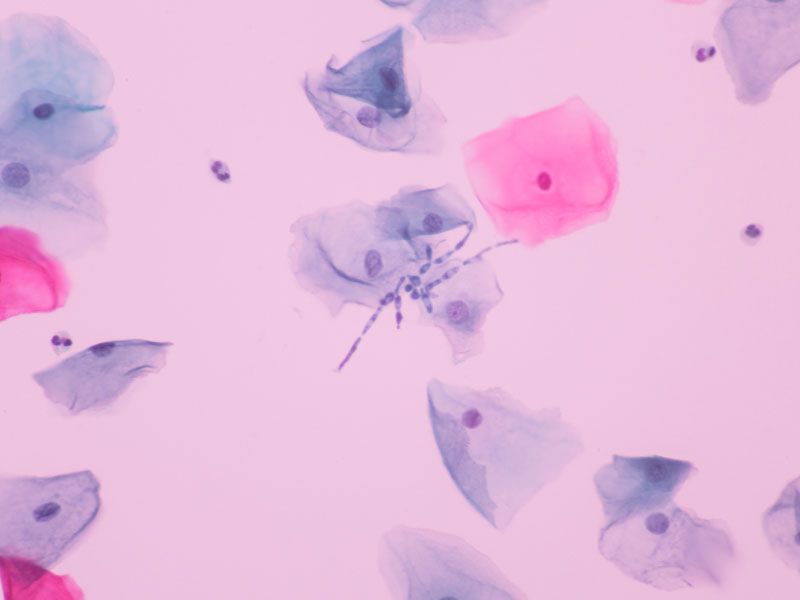
What is HPV Virus?
Published on July 3, 2025
Written by Kathleen Morrison
Medically Reviewed by Andrea Sleeth WHNP-BC, MSCP
Human Papillomavirus (HPV) is super common. Most folks will come into contact with it at some point in their lives, and often, your body clears it on its own without you even knowing.
So, what is it exactly? HPV isn’t just one thing—it’s actually a whole group of over 100 related viruses. Some types can cause genital warts, while others are linked to certain types of cancer down the line. But before you spiral, here’s the thing: having HPV doesn’t mean something’s wrong with you, and it definitely doesn’t make you any less worthy of love, fun, or good sex.
The key? Knowing what’s up and being proactive about your sexual health through regular screening and HPV testing, and paying attention to your body.
Human Papillomavirus 101
HPV might sound like a big, scary word, but it’s actually a huge family of viruses that tons of people around the world have.
These viruses hang out on your skin and mucous membranes—think spots like your genitals, mouth, and throat. If you’re sexually active, chances are you’ll come across at least one type of HPV at some point in your life. It’s way more common than you might think.
What is HPV?
HPV isn’t just one virus—it’s more like a whole squad, with over 100 different strains. Each one has a number (like HPV-16 or HPV-18), and about 40 of these specifically like to hang around the genital area. The virus spreads through direct skin-to-skin contact, not through blood or bodily fluids like some other infections.
Your immune system is your best friend here. Around 90% of HPV infections get cleared by your body within two years without you even needing treatment. That’s why so many people don’t even realize they’ve had it—your body’s natural defenses usually handle it like a champ.
How common is HPV?
It’s super common. Around 79 million people in the U.S. have HPV, and each year, about 14 million new people get infected—that’s more than all other sexually transmitted infections combined.
Young adults, especially in their late teens and twenties, tend to have the most new cases. That’s why having easy, discreet access to care matters so much.
Different types of HPV
Not all HPV strains are the same—some are pretty chill, while others deserve a bit more attention. Knowing the difference helps you stay on top of your health without stress.
Low-risk vs. high-risk HPV types
Low-risk HPV:
- Includes HPV-6 and HPV-11
- Cause about 90% of genital warts
- Rarely linked to cancer, but warts can be uncomfortable or upsetting
- Warts might appear as small or large bumps—single or in clusters—in the genital area
High-risk HPV:
- Includes HPV-16, HPV-18, and others like 31, 33, 45, 52, 58
- Linked to up to 99% of cervical precancers, depending on the type
- Type 16 causes about 50% of cervical cancers
- Types 16 and 18 together account for around 66% of cervical cancers
- And types 31, 33, 45, 52, and 58 cause another 15% of cervical cancers
High-risk HPV often shows no visible signs like warts, which is why regular screening matters. It can quietly (and sneakily) cause cell changes over time before cancer develops.
Where HPV shows up
Different HPV strains like different spots. The common warts you might see on your hands or feet usually come from types 1, 2, and 4. Plantar warts—those pesky bumps on the bottoms of your feet—are mostly types 1 and 2. Flat warts, which can pop up on your face or legs, are usually from types 3 and 10.
When it comes to cancers linked to HPV, it’s not just the cervix that’s affected. HPV-16, for example, is connected to cancers in the throat, anus, penis, vagina, and vulva. That’s why keeping up with screenings and check-ups is a smart move—it helps catch changes early, before things get serious.
How does HPV spread?
Understanding transmission helps you make informed decisions about your health. HPV spreads differently than many other infections, which explains why it's so common.
How you can catch HPV
HPV mainly passes through intimate skin-to-skin contact during vaginal, anal, or oral sex. Here’s how it can spread:
- Through vaginal, anal, or oral sex with an infected partner
- Via any genital skin-to-skin contact, even without intercourse
- During oral sex, which can cause infections in the mouth and throat
- Rarely, from a pregnant person with genital warts to their baby during childbirth, possibly causing warts in the baby’s throat
Condoms help lower your chances, but don’t cover every area the virus can live on, so they aren’t 100% foolproof.
Who's at risk?
Anyone who’s sexually active can get HPV—it’s super common. The risk goes up if you or your partner(s) have had multiple sexual partners or if you started having sex at a younger age, since the cervix isn’t fully mature in teens and young adults.
If your immune system isn’t at full strength—like if you have HIV, have had an organ transplant, or take certain medications—you might have a harder time clearing HPV. Smoking also makes it tougher for your body to fight off the virus.
Signs and symptoms of HPV
Most HPV infections don’t show any symptoms at all—that’s why regular screening is such a game-changer. When symptoms do pop up, they really depend on which type of HPV is involved.
Common symptoms (in men and women)
Genital warts are the most noticeable sign of some HPV types. These can show up weeks or even months after you’ve been exposed. For women, warts might appear on:
- The vulva
- The cervix
- Around the anus
For men, they can show up on:
- The penis
- The scrotum
- Around the anus
- They can be a single bump or a cluster, small or large, flat or raised.
Some people might feel itching or discomfort down there, and sometimes warts can bleed during sex or cause pain. HPV in the throat usually doesn’t cause symptoms, but in rare cases, warts there might affect your voice or breathing. Most of the high-risk HPV types don’t cause any symptoms until they start changing cells.
What genital warts look and feel like
Genital warts come in all shapes and sizes. They might:
- Look like tiny flesh-colored bumps
- Have a cauliflower-like appearance
- Be so small you’d need a microscope to see them
Warts can appear alone or in clusters, and they might grow larger without treatment. Keep in mind, too, that low-risk HPV types that cause warts are different from the high-risk ones linked to cancer.
Can you have HPV without symptoms?
Absolutely. Most of the time, HPV just hangs out quietly—no symptoms, no warning signs. You can have it and even pass it on without knowing. That’s why HPV spreads so easily.
Because these silent infections can still cause cell changes over time, regular screenings like Pap smears and HPV tests are key. These tests can detect abnormal cells and catch issues early before they turn into bigger problems. Don’t wait for symptoms—getting checked regularly is your best move.
The link between HPV and cancer
Understanding the link between HPV and cancer is one of those game-changing medical discoveries. Knowing how they connect puts you in the driver’s seat when it comes to your health.
How an HPV infection can lead to cancer
HPV doesn’t cause cancer overnight. It’s a slow process that usually takes years or even decades. Certain high-risk types of HPV produce special proteins—E6 and E7—that mess with your cells’ natural defenses. These proteins turn off the genes that usually keep cell growth in check, letting those cells go a little wild.
Here’s the usual path: HPV infects your cells. If your immune system kicks it out, great! But if it sticks around, the virus keeps working its mischief. Over time, persistent infection can cause abnormal cell changes called dysplasia or pre-cancer. Without treatment, some of these pre-cancerous changes can turn into cancer.
Types of cancer linked to HPV
Cervical cancer is the poster child for HPV-related cancers—almost all cases start with persistent HPV infection. But HPV is also behind other cancers:
- About 90% of anal cancers
- Around 70% of vaginal and vulvar cancers
- A growing number of throat cancers, especially in men
Even though penis cancer is rare, HPV is involved in about 60% of cases. One silver lining: HPV-positive cancers usually respond better to treatment than those not caused by HPV, especially when it comes to throat cancers. Knowing your HPV status helps your healthcare team tailor the best treatment plan for you.
How long does it take for HPV to cause cancer?
Cancer doesn’t just pop up out of nowhere. Most HPV infections clear on their own within two years. But when the infection sticks around, pre-cancerous changes can develop slowly, often over 10 to 20 years.
Which HPV type you have, how strong your immune system is, and other factors like smoking all influence this timeline. Because this process takes so long, regular screening is a powerful tool to catch issues early, when treatment is easiest and most effective. Cervical pre-cancers can take a decade or more to become invasive cancer, and anal or other HPV-related cancers follow a similar timeline.
Staying ahead of HPV
HPV is common, but that doesn’t mean you’re powerless. Taking charge of your health doesn’t have to be complicated, scary, or wrapped in shame. With the right tools, you can stay one step ahead and make informed, confident choices for your body and your future.
HPV vaccines
The HPV vaccine? Total game-changer. It’s one of the most effective ways to take control of your sexual health and cut your risk of developing certain HPV-related health issues—like genital warts and some cancers—way down.
The most commonly used option, Gardasil 9, protects against nine strains of HPV, including the ones most likely to cause warts and high-risk cancers. The best time to get vaccinated is before you’ve been exposed to HPV, which is why it’s typically recommended for kids around age 11 or 12 (but it can start as early as age 9).
But don’t stress if you didn’t get the vaccine as a teen—you’ve still got options. If you’re 26 or younger, go ahead and get vaccinated now. Even folks between 27 and 45 may benefit, depending on their risk factors and past exposure—just have a quick chat with your healthcare provider.
The dosage depends on when you start:
- If you begin before turning 15: You’ll need two doses.
- If you start at 15 or older: Plan for three doses spaced out over a few months.
Safe practices to support your health
Even if you’ve had the vaccine, there’s more you can do to stay informed and in control.
- Use condoms and dental dams during sex—they’re not perfect barriers, but they do lower the chances of HPV passing between partners.
- Be mindful about your number of sexual partners—not out of shame, but because more partners = more potential exposure.
- Don’t skip regular checkups! The HPV vaccine doesn’t cover every single strain, so screenings like Pap smears and HPV tests still matter.
- If you smoke, now’s a great time to quit—your immune system will thank you.
- Keep the convo open with your partner. Talking about testing, vaccines, and what feels safe for you both is a key part of sexual wellness.
HVP Treatment
Unfortunately, there’s no magic pill that kicks HPV out of your system overnight. But that doesn’t mean you’re stuck. While the virus itself has to run its course, you’ve got lots of options to deal with the health problems it can cause, like warts or abnormal cell changes. The key is knowing your options and teaming up with a provider who gets it.
Can you cure HPV?
Short answer? Nope.
Long answer? Your body is pretty amazing at handling HPV on its own.
Most infections clear up within a couple of years without you ever knowing they were there. There’s no treatment that zaps the virus itself, but there are ways to stay on top of symptoms or complications that pop up along the way.
If you’re wondering how to help your immune system do its thing, focus on the basics:
- Eat nourishing foods (yes, leafy greens count!)
- Get enough sleep (your body heals while you snooze)
- Keep stress in check
- Avoid smoking, since it can weaken your immune defenses
Managing symptoms
When HPV shows up with visible symptoms, there are plenty of treatment options:
- Topical creams like imiquimod help your body fight the warts directly
- Podofilox and sinecatechins are other prescription options your provider might recommend
- For more stubborn warts, in-office procedures like cryotherapy (freezing), electrocautery (burning), or laser removal get the job done
- Surgical removal is also an option, especially for larger growths or if nothing else works
If HPV has caused changes to your cervical cells (often found during a Pap or HPV test), treatment looks a little different:
- Watchful waiting is totally valid if the changes are mild—your body often clears them without needing intervention
- If the changes are more advanced, your provider might recommend:
- LEEP, which uses a small heated wire loop to remove abnormal cells
- Cone biopsy, which removes a small, cone-shaped piece of tissue from the cervix
Both of these are usually outpatient procedures that are fertility-friendly and super effective when things are caught early.
HPV and your body
So, what is the HPV virus? Well, it's incredibly common, manageable, and nothing to be ashamed of. What really matters is knowing how it works, how it shows up in your life (or doesn’t), and what steps you can take to feel confident in your care.
Understanding HPV puts you in the driver’s seat. Whether you’re exploring vaccines, staying on top of regular screenings, managing symptoms like warts, or just starting to learn what this virus even is, every bit of knowledge gives you more control.
While there’s no cure for the virus itself, most HPV infections clear on their own. For the rest, effective treatments are available to help you handle whatever comes up, physically and emotionally. You are not alone in this.
At Wisp, we’re all about making sexual healthcare feel easy, inclusive, and actually helpful. Whether you need prescription support, discreet at-home testing, or just someone who gets it, we’ve got you.
Frequently Asked Questions (FAQ):
What exactly causes HPV?
HPV is caused by the human papillomavirus, which spreads through intimate skin-to-skin contact—like vaginal, oral, or anal sex. Most people get it at some point, even if there are no obvious symptoms.
Is HPV a serious virus?
Some types can be, especially if they hang around for a while. High-risk strains are linked to cancers like cervical and anal, but most infections don’t cause problems and go away on their own.
What does HPV look like on a woman?
If it causes visible symptoms, they’re usually genital warts—small, flesh-colored bumps around the vulva, cervix, or anus. But many HPV types don’t show up at all without screening.
Do you get rid of HPV?
There’s no direct cure, but your immune system is usually up to the task. Most people clear the virus naturally, and symptoms like warts or abnormal cells can be treated with expert care.
This blog post is for informational and educational purposes only and should not be taken as professional advice. Always consult with a qualified professional before making any decisions based on the information provided here.




